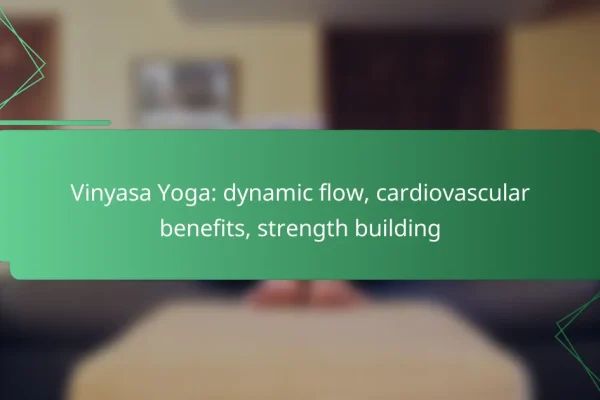What are the benefits of Hatha Yoga?
Hatha Yoga offers numerous benefits, focusing on physical postures, breathing techniques, and relaxation. This style is particularly effective for beginners and those seeking a balanced approach to yoga practice.
Improves flexibility
Hatha Yoga is known for enhancing flexibility through a variety of poses that stretch and lengthen muscles. Regular practice can lead to noticeable improvements in joint mobility and muscle elasticity, making everyday activities easier.
To maximize flexibility gains, aim for at least two to three sessions per week, holding each pose for 20-30 seconds. Gradually increase the duration as your body adapts.
Enhances strength
In addition to flexibility, Hatha Yoga builds strength by engaging various muscle groups during poses. Many postures require you to support your body weight, which can lead to increased muscle tone and endurance over time.
Incorporate poses like Plank and Warrior to target core and leg strength. Consistent practice can help you develop a balanced physique while reducing the risk of injury.
Reduces stress
Hatha Yoga is effective in reducing stress levels through its emphasis on breath control and mindfulness. The combination of physical movement and focused breathing helps to calm the mind and promote relaxation.
To enhance stress reduction, practice in a quiet environment and dedicate time to deep breathing exercises. Aim for 30 minutes of Hatha Yoga several times a week to experience significant stress relief.
Promotes mindfulness
Mindfulness is a key component of Hatha Yoga, encouraging practitioners to stay present and aware during their practice. This focus can lead to improved mental clarity and emotional stability.
To cultivate mindfulness, pay attention to your breath and sensations in your body throughout each pose. Consider incorporating meditation or guided relaxation techniques to deepen your practice and enhance overall well-being.
How does Vinyasa Yoga benefit practitioners?
Vinyasa Yoga offers numerous benefits that enhance physical and mental well-being. This dynamic style of yoga emphasizes breath-synchronized movement, which can improve overall fitness and promote relaxation.
Increases cardiovascular fitness
Vinyasa Yoga can significantly enhance cardiovascular fitness by incorporating continuous movement and varied poses. Practitioners often experience an elevated heart rate, which helps improve circulation and endurance over time.
To maximize cardiovascular benefits, aim for sessions that last at least 30 minutes, focusing on maintaining a steady flow between poses. This approach can lead to improved heart health and increased stamina.
Encourages weight loss
Engaging in Vinyasa Yoga can support weight loss efforts by burning calories and building muscle. The intensity of the practice varies, but a vigorous session can burn several hundred calories, making it an effective workout.
For optimal weight loss, combine Vinyasa sessions with a balanced diet and other forms of exercise. Consistency is key; aim for at least three sessions per week to see noticeable results.
Boosts energy levels
Practicing Vinyasa Yoga can lead to increased energy levels by improving blood flow and oxygen delivery throughout the body. The rhythmic nature of the practice helps to invigorate both the body and mind.
To harness this energy boost, consider practicing in the morning or during midday breaks. Short sessions of 20-30 minutes can effectively recharge your energy and enhance focus for the rest of the day.
What advantages does Ashtanga Yoga offer?
Ashtanga Yoga provides numerous benefits, including improved physical fitness, mental clarity, and emotional balance. This dynamic style emphasizes a structured sequence of postures, which can lead to enhanced overall well-being.
Builds discipline
Ashtanga Yoga requires practitioners to follow a specific sequence of poses, fostering a sense of discipline. This consistent practice encourages commitment and routine, which can extend beyond the mat into daily life.
To cultivate discipline, aim to practice at the same time each day, gradually increasing the duration as you become more comfortable. This structured approach helps reinforce habits that promote personal growth.
Enhances stamina
The vigorous nature of Ashtanga Yoga significantly boosts stamina. The continuous flow of postures elevates the heart rate, improving cardiovascular health and endurance over time.
For best results, incorporate breath control (ujjayi breathing) during your practice. This technique not only enhances physical stamina but also helps maintain focus and energy throughout the session.
Improves focus
Ashtanga Yoga sharpens mental focus through its meditative aspects and the synchronization of breath with movement. This practice encourages mindfulness, allowing individuals to concentrate on their physical and mental states.
To enhance focus, set clear intentions for each session. Consider practicing in a quiet space free from distractions to deepen your concentration and connection to the practice.
What are the unique benefits of Bikram Yoga?
Bikram Yoga offers several unique benefits, primarily through its practice in a heated room, which enhances flexibility and promotes detoxification. This style of yoga consists of a series of 26 postures and two breathing exercises, designed to systematically work every part of the body.
Detoxifies the body
The heat in Bikram Yoga promotes sweating, which helps to flush out toxins from the body. This detoxification process can lead to improved skin health and a reduction in the risk of certain illnesses. Regular practice may also enhance kidney function, as the body works to eliminate waste more efficiently.
Improves joint health
Bikram Yoga’s series of postures encourages joint mobility and flexibility, which can alleviate stiffness and reduce the risk of injury. The heat helps to warm up the muscles and joints, making it easier to perform movements that might otherwise be challenging. This can be particularly beneficial for individuals with arthritis or other joint-related issues.
Enhances mental clarity
Practicing Bikram Yoga can improve mental clarity by promoting mindfulness and focus during the sessions. The combination of physical exertion and controlled breathing encourages a meditative state, which can reduce stress and anxiety. Many practitioners report feeling more centered and clear-headed after their sessions.
How can Yin Yoga support emotional well-being?
Yin Yoga can significantly enhance emotional well-being by promoting mindfulness and reducing stress. This practice encourages deep relaxation and introspection, allowing individuals to process emotions and cultivate a sense of inner peace.
Promotes relaxation
Yin Yoga promotes relaxation by focusing on long-held postures that target connective tissues and fascia. This gentle stretching helps release tension stored in the body, leading to a calmer mind and reduced anxiety levels.
During a typical Yin Yoga session, poses are held for several minutes, allowing the body to gradually relax and open. This extended duration encourages a meditative state, which can help clear mental clutter and foster emotional clarity.
To maximize relaxation, practitioners should create a soothing environment, using props like bolsters and blankets for support. Soft lighting and calming music can further enhance the experience, making it easier to unwind and let go of stress.










